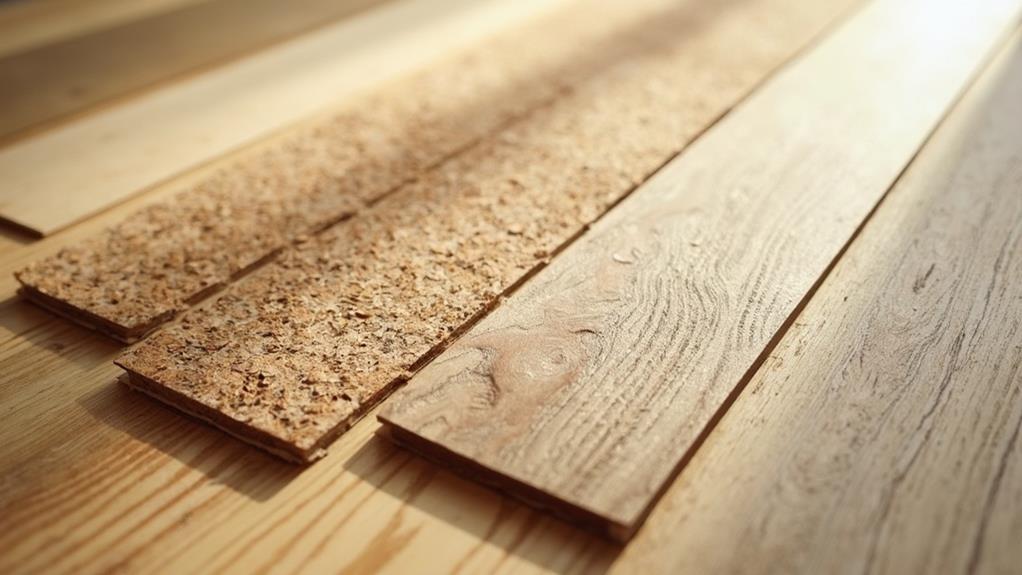Frugal flooring options offer homeowners cost-effective ways to update their spaces without breaking the bank. Vinyl plank flooring provides durability and water resistance, while laminate offers a budget-friendly alternative to hardwood. Peel-and-stick tiles present an easy DIY solution, and painted concrete floors allow for customization at a fraction of the cost. Cork flooring combines eco-friendliness with comfort, and updated linoleum designs offer modern aesthetics. Refinishing existing hardwood can breathe new life into old floors, while strategic use of area rugs can instantly transform a room. These affordable options cater to various styles and budgets, providing ample opportunities to revitalize any space.
Vinyl Plank Flooring
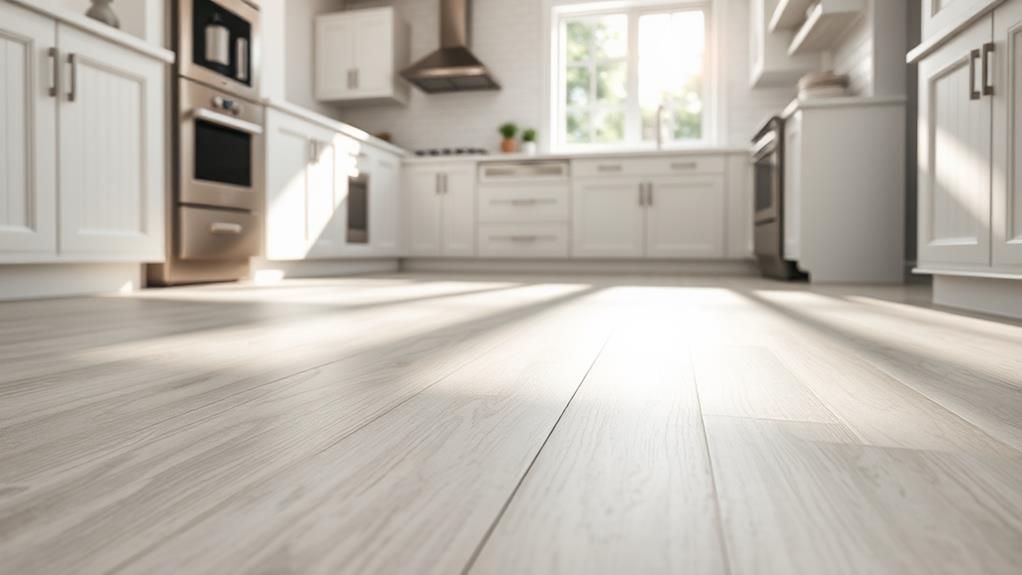
Why has vinyl plank flooring become increasingly popular among homeowners and designers? This affordable option offers a perfect blend of durability, aesthetics, and cost-effectiveness. Vinyl plank flooring mimics the look of hardwood while providing superior water resistance and easier maintenance. Its layered construction includes a wear layer, design layer, core layer, and backing, resulting in a product that can withstand high traffic and moisture exposure.
Installation of vinyl plank flooring is relatively simple, often featuring click-lock or peel-and-stick systems that allow for DIY projects. This can significantly reduce overall costs compared to professional installation of other flooring types.
Available in a wide range of colors, patterns, and textures, vinyl plank flooring can suit various design preferences and complement diverse interior styles.
One of the main advantages of vinyl plank flooring is its affordability. Priced considerably lower than hardwood or stone alternatives, it offers an economical solution for budget-conscious homeowners. Additionally, its long lifespan and low maintenance requirements contribute to cost savings over time. With advancements in manufacturing technology, modern vinyl plank flooring also addresses concerns about VOC emissions, making it an increasingly eco-friendly choice for sustainable home design.
Laminate Options
Numerous homeowners turn to laminate flooring as another cost-effective alternative to traditional hardwood or tile. This durable option consists of multiple layers, including a high-density fiberboard core and a photorealistic image layer that mimics the appearance of wood, stone, or tile. A clear protective layer on top enhances durability and scratch resistance.
Laminate flooring offers several advantages, including easy installation with click-lock systems, making it suitable for DIY projects. It's also low-maintenance, requiring only regular sweeping and occasional damp mopping. Available in a wide range of styles and colors, laminate can complement various interior design themes.
While laminate is generally more affordable than hardwood, prices can vary based on quality and thickness. Higher-end options may feature enhanced water resistance and texture for a more realistic look and feel. When selecting laminate, consider factors such as AC rating for durability, thickness for sound insulation, and underlayment requirements. Although not as long-lasting as solid hardwood, quality laminate can provide an attractive, budget-friendly flooring solution for 10-20 years with proper care and maintenance.
Peel-and-Stick Tiles
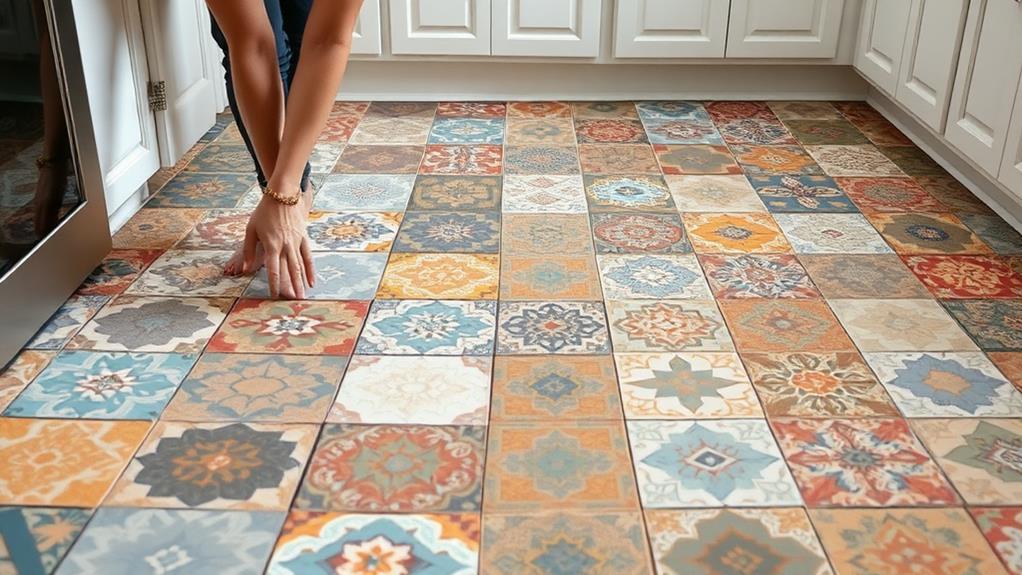
Peel-and-stick tiles have gained popularity as an affordable and user-friendly flooring option. These versatile tiles are available in a wide range of designs, colors, and patterns, allowing homeowners to achieve the look of more expensive flooring materials at a fraction of the cost. Made from vinyl or other synthetic materials, peel-and-stick tiles are durable, water-resistant, and easy to maintain.
Installation is straightforward, requiring minimal tools and expertise. The adhesive backing allows for direct application to clean, smooth surfaces, making them ideal for DIY projects. Peel-and-stick tiles can be installed over existing flooring, saving time and money on removal costs. They are particularly suitable for rental properties or temporary living situations, as they can be easily removed without damaging the subfloor.
While peel-and-stick tiles offer numerous advantages, they do have limitations. They may not be as long-lasting as traditional flooring options and can be prone to lifting or shifting over time, especially in high-traffic areas. However, for budget-conscious homeowners seeking a quick and affordable flooring solution, peel-and-stick tiles provide an attractive alternative that can instantly update the look of any room.
Painted Concrete Floors
Another cost-effective flooring option that has gained traction in recent years is painted concrete floors. This versatile solution transforms existing concrete surfaces into attractive, durable floors suitable for both residential and commercial spaces. The process involves thoroughly cleaning the concrete, repairing any cracks or imperfections, and then applying specialized concrete paint or epoxy coating.
Painted concrete floors offer numerous advantages. They are highly customizable, allowing for a wide range of colors, patterns, and finishes to suit any aesthetic. The cost is significantly lower than installing new flooring materials, making it an excellent choice for budget-conscious homeowners or businesses. Additionally, these floors are easy to maintain, resistant to stains and wear, and can last for many years with proper care.
However, it's important to note that the success of painted concrete floors depends on proper preparation and application. DIY enthusiasts should carefully research techniques or consider hiring professionals for best results. While initially budget-friendly, high-quality paints and sealants are crucial for longevity and appearance. Overall, painted concrete floors provide an affordable and stylish solution for updating various spaces.
Cork Flooring
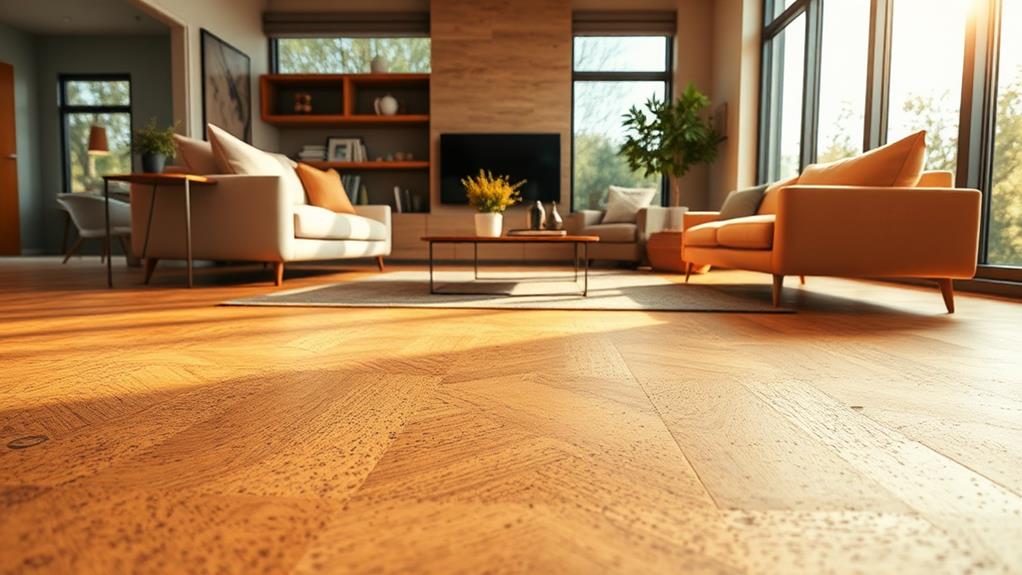
Cork flooring stands out as a unique and eco-friendly option in the world of affordable flooring solutions. Derived from the bark of cork oak trees, this sustainable material offers a combination of comfort, durability, and style. Cork's natural elasticity provides a cushioned surface that's easy on joints, making it ideal for areas where people stand for extended periods, such as kitchens.
One of cork's most appealing features is its thermal insulation properties, which help maintain a comfortable room temperature and potentially reduce energy costs. Additionally, cork is naturally resistant to mold, mildew, and insects, contributing to a healthier indoor environment. Its sound-absorbing qualities make it an excellent choice for multi-story homes or apartments.
Available in various colors and patterns, cork flooring can complement diverse interior design styles. While generally more affordable than hardwood, cork does require periodic sealing to maintain its water-resistant properties. With proper care, cork floors can last 20-30 years, offering long-term value. Installation is relatively straightforward, often utilizing a click-lock system suitable for DIY enthusiasts, further reducing overall costs.
Updated Linoleum Designs
Long gone are the days when linoleum was considered outdated or unappealing. Modern linoleum flooring has undergone a significant transformation, offering a wide array of stylish designs, colors, and patterns that can complement any interior aesthetic. This eco-friendly and durable material is experiencing a resurgence in popularity due to its affordability and versatility.
Today's linoleum options include realistic wood and stone imitations, bold geometric patterns, and vibrant solid colors. Manufacturers have improved the material's resistance to wear, stains, and fading, making it a practical choice for high-traffic areas. Linoleum is also naturally antimicrobial and hypoallergenic, contributing to better indoor air quality.
Installation of updated linoleum designs is relatively simple, with options for click-lock floating floors or adhesive-based applications. This material is low-maintenance, requiring only regular sweeping and occasional damp mopping to maintain its appearance. With a lifespan of 20-40 years when properly cared for, linoleum offers excellent value for budget-conscious homeowners. Its natural composition of linseed oil, cork dust, and wood flour makes it a sustainable choice for environmentally conscious consumers seeking an affordable flooring solution.
Refinishing Existing Hardwood
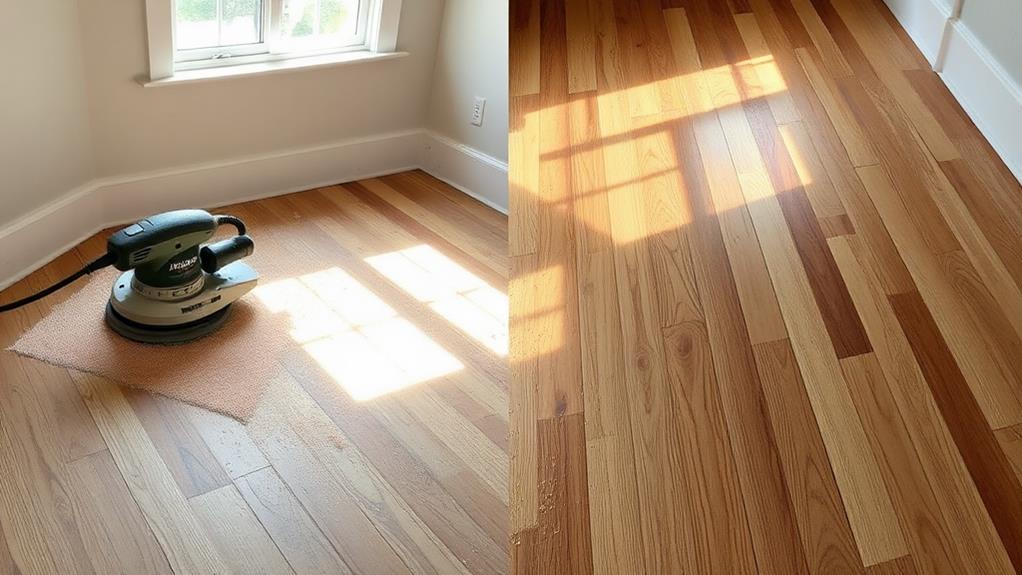
For homeowners seeking an affordable flooring upgrade, refinishing existing hardwood floors presents an excellent opportunity to revitalize their living space without the expense of new installation. This process involves sanding down the current surface to remove scratches, dents, and old finishes, then applying a fresh stain and protective coating.
The cost of refinishing hardwood is significantly lower than replacing the flooring entirely, typically ranging from $3 to $8 per square foot. This price variation depends on factors such as the floor's condition, the type of wood, and the chosen finish. Homeowners can further reduce costs by tackling some preparatory work themselves, such as removing furniture and baseboards.
Refinishing not only restores the floor's appearance but also extends its lifespan. The process allows for customization through different stain colors and finishes, from matte to high-gloss. While it requires temporarily vacating the space and can create dust, the results are often dramatic. With proper care, refinished hardwood floors can last for decades, making this a cost-effective and visually appealing option for budget-conscious homeowners looking to update their flooring.
Area Rug Strategies
While refinishing hardwood floors offers a comprehensive solution, area rugs provide a versatile and budget-friendly approach to transforming living spaces. These portable floor coverings can instantly update a room's aesthetic, add warmth, and protect underlying surfaces. When selecting area rugs, consider size, material, and style to complement your existing décor.
For maximum impact, choose a rug that anchors the furniture arrangement. In living rooms, ensure the rug is large enough to accommodate at least the front legs of all seating pieces. In dining areas, select a rug that extends beyond the table and chairs when pulled out. To create visual interest, layer rugs of different sizes and textures.
Natural fiber rugs, such as jute or sisal, offer durability and affordability. Synthetic options like polypropylene provide stain resistance and easy maintenance. For a cohesive look, use multiple smaller rugs in coordinating colors or patterns throughout your home. Consider seasonal rotation to refresh your space periodically. By strategically placing area rugs, you can define zones in open-concept layouts, soften hard surfaces, and absorb sound, all while staying within budget.
Frequently Asked Questions
How Do I Prepare My Subfloor for New Flooring Installation?
To prepare your subfloor for new flooring installation, start by cleaning the surface thoroughly. Repair any damage, level uneven areas, and ensure the subfloor is dry. Address moisture issues if present, and follow manufacturer-specific guidelines for your chosen flooring type.
What Tools Are Essential for DIY Flooring Projects?
For DIY flooring projects, essential tools include a tape measure, utility knife, tapping block, spacers, pry bar, and hammer. Additionally, you'll need a saw (circular or jigsaw), level, knee pads, and appropriate adhesives or fasteners for your specific flooring type.
How Long Does It Typically Take to Install Different Types of Flooring?
Installation times for flooring vary widely depending on the type and room size. Generally, carpet takes 1-2 days, hardwood 2-4 days, laminate 1-3 days, vinyl 1-2 days, and tile 3-5 days for an average-sized room.
Are There Eco-Friendly Options for Affordable Flooring?
Like a breath of fresh air, eco-friendly flooring options are plentiful and affordable. Bamboo, cork, and reclaimed wood offer sustainable choices. Recycled rubber and linoleum provide durable, green alternatives. Low-VOC vinyl and carpets made from recycled materials are also available.
What Maintenance Is Required for Various Budget-Friendly Flooring Materials?
Maintenance requirements for budget-friendly flooring vary. Vinyl and laminate need regular sweeping and occasional mopping. Carpet requires vacuuming and periodic deep cleaning. Hardwood floors need sweeping, occasional damp mopping, and periodic refinishing to maintain their appearance and durability.
Conclusion
In conclusion, these economical flooring alternatives offer a wealth of possibilities for enhancing living spaces without depleting one's financial resources. From the durability of vinyl planks to the eco-friendly nature of cork, each option presents unique advantages. With creative approaches like revitalizing existing hardwood or strategically placing area rugs, even those with modest means can achieve a significant transformation. By exploring these budget-conscious solutions, individuals can elevate their surroundings and create a more inviting atmosphere without resorting to extravagant expenditures.
